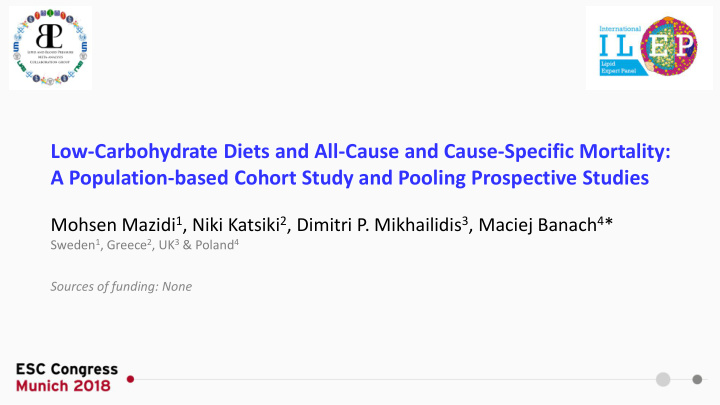



Low-Carbohydrate Diets and All-Cause and Cause-Specific Mortality: A Population-based Cohort Study and Pooling Prospective Studies Mohsen Mazidi 1 , Niki Katsiki 2 , Dimitri P. Mikhailidis 3 , Maciej Banach 4 * Sweden 1 , Greece 2 , UK 3 & Poland 4 Sources of funding: None
Background • The pandemic of obesity is a major health issue. Obesity is a predisposing factor for several chronic diseases, including CVD, hypertension, type 2 DM and cancer. • There is controversy over the benefit of well-balanced diets and CV health. For example,- low-carbohydrate diets (LCDs) have become popular in the last 20 years. • Long-term safety of consuming LCDs remains controversial, and some available studies suggest that LCD may increase the risk of CVD, total and cancer-specific morbidity and mortality. However there are also single studies that reported controversial and opposite results (lower CVD risk with LCD or no association with mortality) in different populations.
Purpose and key points about methods • We prospectively examined the relation between LCD and all-cause and cause-specific (CVD, stroke and cancer) mortality in a large and nationally representative US cohort. We validated these results in a systematic review and meta-analysis of available prospective studies that examined these associations. • Using data from the NHANES study (survey cycles 1999-2010, n=24,825; mean follow-up 6.4 years ), we estimated the energy adjusted intakes of protein, fat and carbohydrates for each individual, using the residual method. This allows evaluation of the effect of an energy generating nutrient, by using a simple regression of that given nutrient on energy intake to calculate the residual. The carbohydrate categories were scored from 10 (lowest intake) to 0 (highest intake). • The meta-analysis was designed, conducted and reported according to the MOOSE guidelines. Finally 7 prospective cohort studies with 447,506 participants (mean follow-up 15.6 years) published up to February 1, 2018 were included. We used adjusted Cox regression to determine the risk ratio (RR) and 95%CI, as well as random effects models and generic inverse variance methods, followed by a leave-one-out method for sensitivity analysis.
Results: NHANES data Q1 was considered as reference; Model 1 was adjusted for age, gender, race, education, marital status, poverty to income ratio, total energy intake, physical activity, smoking and alcohol consumption; Model 2 was additionally adjusted for age, sex, gender, education, marital status, poverty to income ratio, total energy intake, physical activity, smoking, alcohol consumption, body mass index, hypertension, serum total cholesterol and diabetes . We also examined the link between total mortality and LCD for obese (BMI ≥ 30 kg/m 2 ) vs non-obese (BMI <30 kg/m 2 ) participants ; the link was stronger in the non-obese participants [obese= Q2: 1.02 (1.01-1.09), Q3: 1.11 (1.03-1.23), Q4: 1.19 (1.11-2.25) vs. non- obese= Q2: 1.13 (1.07-1.19), Q3: 1.25 (1.11-1.76), Q4: 1.48 (1.37-2.01) , p-interaction <0.001 ). In age groups (≥ 55 vs <55 years) the link between LCD and total mortality was stronger for older participants (younger = Q2: 1.08 (1.02-1.012, Q3: 1.09 (1.03-1.20), Q4: 1.17 (1.10-2.01) vs older= Q2: 1.19 (1.10-1.30), Q3: 1.29 (1.13-1.63), Q4: 1.52 (1.41-1.79) , p-interaction <0.001 ).
Results: Meta-analysis We showed a positive association between LCD and total mortality ( RR: 1.15, A significant link between LCD score and CVD mortality was observed ( RR: 1.13, 1.07-1.22, p <0.001 , n=7 studies), with no risk of heterogeneity ( I 2 =8.6, p =0.912). 1.02-1.24, p <0.001 , n=6 studies), with no sign of heterogeneity ( I 2 :11.2, p =0.849). Similar results were obtained for LCD score and risk of cancer mortality ( RR: 1.08, 1.01-1.14, p =0.02 , n=3 studies), with no sign of heterogeneity ( I 2 :10.3, p =0.902).
Conclusions and Key messages • Impact on clinical practice: Our study highlighted the unfavorable long-term effect of LCD on total and cause- specific mortality, based on both individual data and pooling previous cohort studies. Further studies to assess the effect of diet duration and clarify the mechanisms involved in these associations are eagerly awaited. These results might help policy makers to increase public awareness about the role of LCDs, and their potential harmful effects. • Impact on every-day life: Short-term diet with low carbohydrates might be useful in order to improve body weight, blood pressure, and parameters like blood glucose and lipids. However, given that LCD diets seem to be unsafe, especially long-term, it would be preferable not to recommend such diets, at least until further evidence becomes available.
Recommend
More recommend